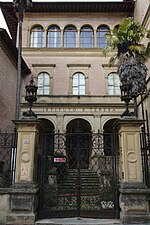San Niccolò al Carmine, Siena
16th-century Roman Catholic church buildings in ItalyRenaissance architecture in SienaRoman Catholic churches in Siena

San Niccolò al Carmine, also called Santa Maria del Carmine is a Renaissance style, Roman Catholic church and monastery located in Pian dei Mantellini #30, near the corner of Via della Diana in the Terzo de Citta of Siena, region of Tuscany, Italy. The church now serves as the Oratory for the Contrada of Pantera. Across the street from the belltower is the Palazzo Celsi Pollini. North along Pian dei Mantellini, toward the Arco delle Due Porte, and on the same side of the street are a number of palaces built around what was once the Monastery of the Derelict Women: in order they are the Neoclassical Palazzo Incontri, the Palazzo Ravissa and the Palazzo Segardi.
Excerpt from the Wikipedia article San Niccolò al Carmine, Siena (License: CC BY-SA 3.0, Authors, Images).San Niccolò al Carmine, Siena
Pian dei Mantellini, Siena
Geographical coordinates (GPS) Address External links Nearby Places Show on map
Geographical coordinates (GPS)
| Latitude | Longitude |
|---|---|
| N 43.314199 ° | E 11.327392 ° |
Address
San Niccolò al Carmine
Pian dei Mantellini
47065 Siena
Tuscany, Italy
Open on Google Maps











